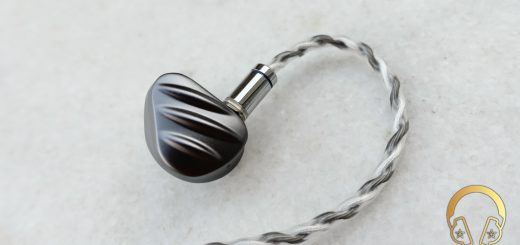ZiiGaat Horizon Review
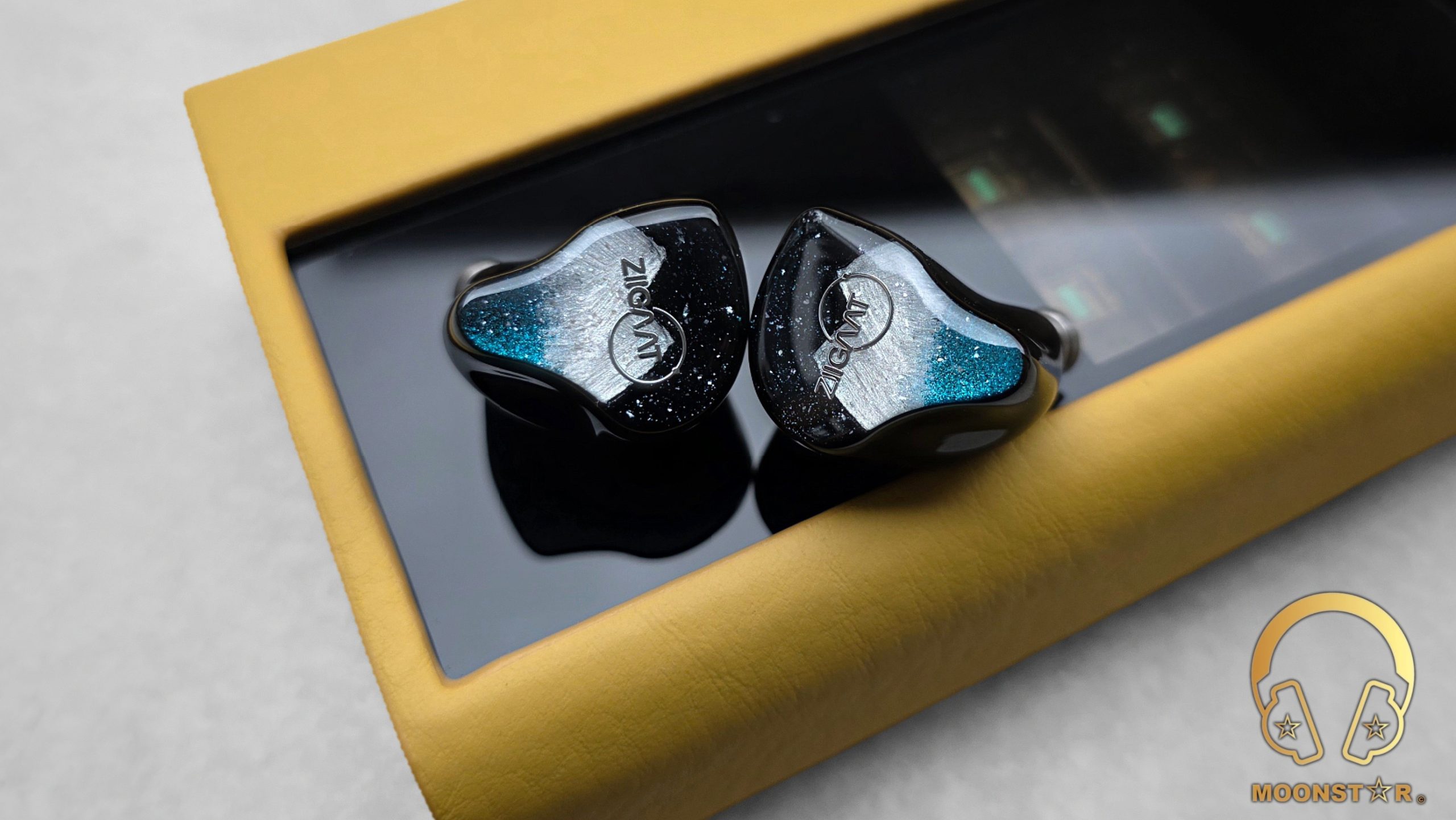
ZiiGaat Horizon Review
Introduction:
The ZiiGaat Horizon utilizes a five-driver tribrid configuration engineered to achieve a neutral sound profile characterized by clarity and refinement. The internal driver setup systematically covers the full audio spectrum: A single 10mm bio-cellulose dynamic driver is responsible for the low frequencies, focusing on reproduction speed and textural detail. The critical midrange, which processes vocals and fundamental instrumental tones, is managed by two Knowles 30262-163 balanced armature (BA) drivers. Finally, two custom composite planar drivers are assigned to the high frequencies, contributing to an extended high-frequency response and perceived airiness. This complex, multi-driver approach is employed to produce the Horizon’s balanced sonic characteristics.
The physical construction of the IEM is equally deliberate. The shells are created using 3D-printed resin, which offers durability and precision, while the unique hand-poured faceplates contribute to the aesthetic appeal. The overall shape is designed for an ergonomic fit, aiming to provide secure and comfortable wear for the listener. Furthermore, the Horizon enhances its practicality and connectivity through the inclusion of a high-quality modular cable. This cable provides both 3.5mm single-ended and 4.4mm balanced terminations, offering valuable flexibility that allows users like myself to seamlessly connect the IEMs to virtually any audio source available. This combination of internal technical complexity and practical, well-executed external features defines the Horizon’s overall offering.
This review provides an in-depth look at its aesthetics, comfort level, and audio fidelity to assess its overall value proposition in today’s IEM landscape.

Disclaimer:
I would like to thank Linsoul and ZiiGaat for providing the Horizon Tribrid In-Ear Monitor for review purposes. I am not affiliated with Linsoul and ZiiGaat beyond this review and these words reflect my true and unaltered opinions about the product.
Price & Availability:
The ZiiGaat Horizon is available for $329 USD. More information’s can be found under the link below;
Package & Accessories:
The ZiiGaat Horizon arrives in a compact, functional cardboard box featuring the distinct ZiiGaat logo and a clear image of the IEMs on the exterior. Inside, the contents are securely protected within foam inserts.
The packaging is simple yet practical, clearly prioritizing the safe delivery of the components over an elaborate presentation. However, the packaging design and accessory set are identical to those included with previous ZiiGaat models. While this approach provides consistency across the brand’s lineup, experienced listeners may find the physical unboxing experience familiar rather than novel.

Included in the box:
- 1x Pair of ZiiGaat Horizon IEMs
- 1x Detachable 4-Core Cable (0.78mm 2-pin)
- 1x 3.5mm Plug
- 1x 4.4mm Plug
- 3x Pairs of Silicone Ear Tips (S/M/L)
- 3x Pairs of Transparent Silicone Ear Tips
- 1x Pair of Black Foam Ear Tips
- 1x Premium Carrying Case
- 1x Wearing Diagram/User Instruction Card
- 1x Warranty Card

The inclusion of the modular cable is a notable functional advantage; by offering both the common single-ended (3.5mm) and the high-power balanced (4.4mm) connection options, the cable significantly enhances the Horizon’s versatility across different audio players and DAC/Amplifier setups. I find that this adaptability is crucial for listeners who utilize multiple source devices. Furthermore, the comprehensive selection of various ear tips empowers the listener to fine-tune both the physical fit, which is essential for comfort, and the resulting sonic presentation, allowing for a personalized sound profile. Finally, the practical and spacious carrying case provides reliable protection for the IEMs during daily transport and storage, completing the set of well-considered accessories.


Design & Build Quality:
The ZiiGaat Horizon is characterized by a lightweight and durable construction, utilizing 3D-printed medical-grade resin for its shells. This choice of material allows for high precision in the manufacturing of the shells, which are specifically contoured for ergonomic comfort and designed to be visually appealing. The shells house a sophisticated five-driver tribrid configuration: a single 10mm bio-cellulose dynamic driver manages the low frequencies, two Knowles 30262-163 balanced armatures handle the midrange, and two custom composite planar drivers are dedicated to the high frequencies. I find the ability to contain such complex internal technology within a compact, comfortable resin shell showcases the high level of engineering skill involved in its creation.

A significant amount of attention to aesthetic detail is evident in the hand-poured components. The Horizon’s faceplates are individually crafted from resin, featuring an intricate finish that evokes a mesmerizing, icy landscape with cool blue and white tones and subtle depth effects. Because they are hand-poured, each faceplate presents unique pattern variations, creating a captivating blend of frosty gradients complemented by a dynamic shimmer.

Delicate hints of silver and turquoise are scattered across the surface, adding a touch of elegance that I believe catches the light beautifully. The “ZiiGaat” logo is subtly yet strategically displayed, centered on the faceplate, offering a sleek contrast to the artistic background, and the glossy top finish enhances the overall premium feel.Each faceplate has unique pattern variations, creating a captivating blend of frosty gradients with a dynamic shimmer.
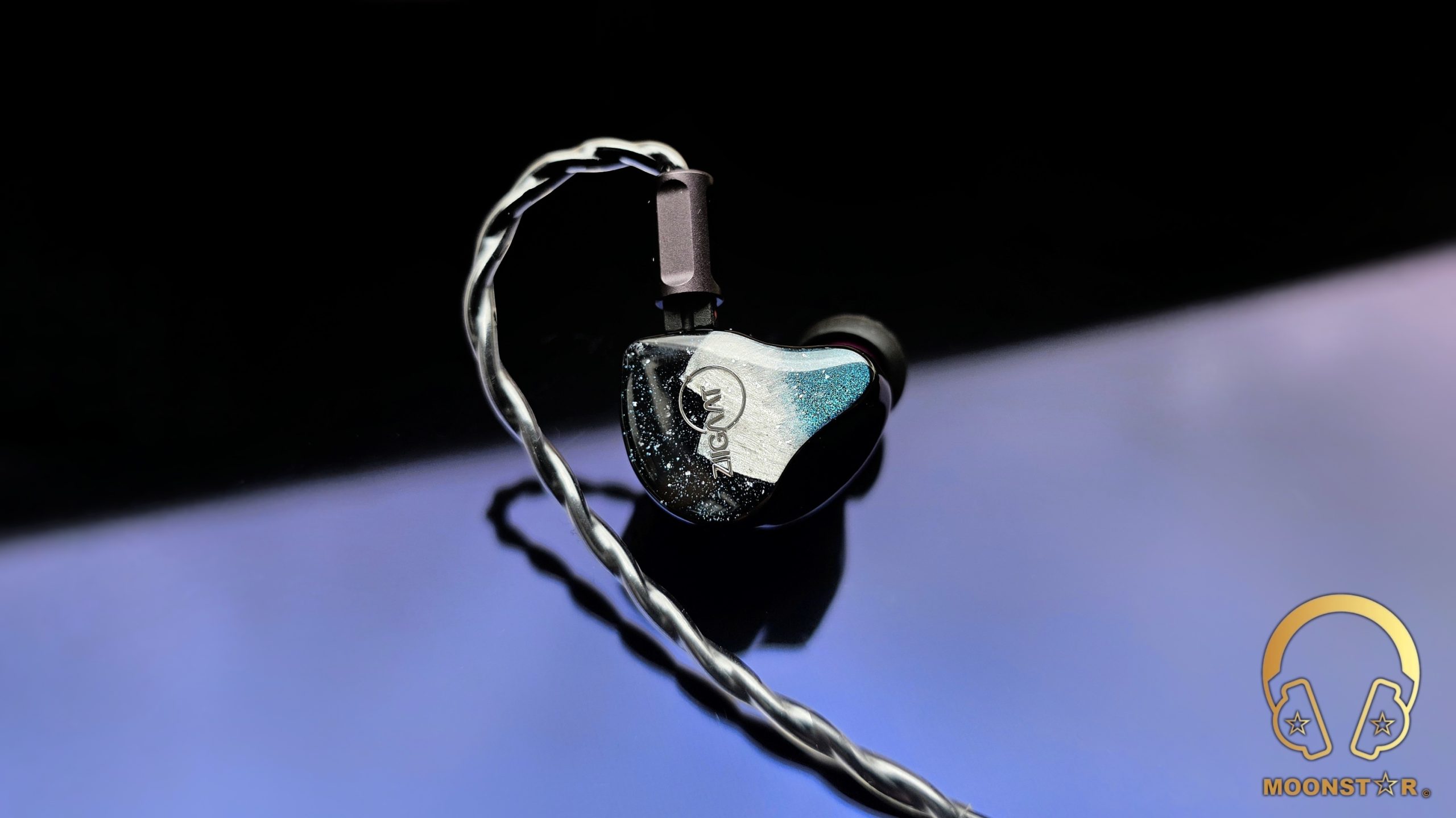
The metal sound nozzle is equipped with a fine mesh, which is essential for preventing debris buildup and ensuring consistent acoustic output over time. Its standard diameter and moderate length allow for excellent compatibility with a wide variety of aftermarket ear tips, enabling users to fully customize the fit. A subtle but crucial lip on the nozzle securely holds ear tips in place, preventing slippage during movement.

The Horizon branding and the unit’s serial number are discreetly located near the nozzle.

The ZiiGaat Horizon employs standard 0.78mm 2-pin connectors, which are subtly integrated into the shell for a secure and stable cable connection. This standardized design allows for easy and safe cable swaps without risking damage, readily accommodating users who prefer to explore aftermarket cables.

Furthermore, a small vent positioned at the rear surface of the shell is designed to aid acoustic performance by ensuring optimal pressure balance within the chamber.

The Horizon arrives complete with a high-quality modular cable, crafted from silver-plated oxygen-free copper, designed to ensure efficient and pure signal transmission. Its lightweight, flexible construction, encased in a simple black sheath, is effective at minimizing microphonics (cable noise) and tangling. The cable’s modular feature is managed by the 3.5mm and 4.4mm plugs, which are housed in sturdy metal casings with clear alignment markers for easy and secure swapping.

Overall, I feel the Horizon’s build quality, combining lightweight resin shells, precise craftsmanship, and the striking artistic faceplate design, delivers a truly premium and reliable product.

Fit, Comfort & Isolation:
The Horizon’s shells are designed with a medium profile and feature ergonomic contours that, in my experience, facilitate a generally secure and comfortable fit for the majority of ear sizes. However, as is common with custom-molded designs, users with highly asymmetrical or particularly small ear canals may find that a slight adjustment period or careful selection of ear tips is necessary to achieve the optimal seal.
Regarding ambient noise, I found the Horizon offers effective passive noise isolation. The design successfully attenuates a noticeable amount of external sound, creating a quiet listening environment that is highly beneficial in busy settings such as public transport or bustling cafes. This level of isolation contributes significantly to the immersive quality of the listening experience.

Technical Specifications:
- Model : Horizon
- Driver Technology : 5 Drivers Tribrid (1 x 10mm Bio-Cellulose DD for bass, 2 x Knowles 30262-163 BA for mids, 2 x Custom Composite Planar for treble)
- Frequency Response : 20Hz–35kHz
- Sensitivity : 102dB
- Impedance : 24Ω
- THD : 0.55%
- Connector Type : 0.78mm 2-Pin
- Plug : Modular 3.5mm Single-Ended, 4.4mm Balanced
- Cable Length : about 120cm

Drivability & Pairing:
The ZiiGaat Horizon In-Ear Monitor (IEM) is fundamentally designed for user convenience, a characteristic highlighted by its 24Ω impedance and 102dB sensitivity. These specifications establish the Horizon as an IEM that requires relatively low power to achieve a satisfying volume and performance level. This inherent efficiency means the device is highly accessible, serving as an easy entry point for those new to high-fidelity audio while also offering veteran enthusiasts a versatile, low-effort option for their daily listening. The Horizon meets the user where they are, offering a rewarding sound experience without demanding specialized or high-powered equipment upfront.
For everyday use and active lifestyles, the Horizon delivers a strong and compelling performance when connected to basic portable sources. Pairing it with devices such as a compact dongle DAC like the ONYX Beta XI2 or an accompanying portable amplifier/DAC combination, such as the iBasso Nunchaku which I found to be excellently balanced, yields a vibrant and engaging sound. These foundational sources provide sufficient power and signal quality for comfortable, on-the-go enjoyment. They facilitate an immediate and hassle-free connection to music, confirming that even simple USB connectivity is enough to power the Horizon effectively for casual listening, ensuring that the enjoyment of music is never needlessly complicated by hardware requirements.

To fully explore the IEM’s technical limits and maximize its precision for critical listening sessions, the choice of source becomes more significant. Upgrading to a premium device, such as the sophisticated iBasso D17 Atheris DAC or the advanced iBasso DX260 MK2 Digital Audio Player (DAP), introduces noticeable enhancements to the audio presentation. These higher-tier sources, with their superior signal processing, act as a catalyst, enriching the Horizon’s output in key areas: they dramatically improve detail resolution by clarifying micro-nuances, broaden the dynamic range for a more impactful and lifelike sound, and expand the soundstage, allowing for a more accurate and three-dimensional perception of instrument placement. In essence, while the Horizon is effortlessly drivable by basic sources, pairing it with specialized equipment allows the dedicated listener to transform it into a refined instrument for detailed audio appreciation.

Equipment’s used for this review:
- IEM’s : ZiiGaat Horizon, BQEYZ Winter II, ROSE Technics QT-X
- DAP&DAC’s : iBasso DX260 MK2, iBasso D17 Atheris, ONYX Beta XI2
- Burn-in Period : 90 – 100 hours
- Ear Tips : Stock Clear Silicone Tips
- Cable : Stock 2-pin Cable
Albums & Tracks Used for this Review:
Vocal Jazz / Smooth Jazz
- Norah Jones – Come Away With Me (Flac 24bit/96kHz)
- Diana Krall – So Wonderful (DSF)
- Barry White – Just The Way You Are (Flac 24bit/48kHz)
- Isaac Hayes – Walk On By (Flac 16bit/44.1kHz)
- Sting – Englishman in New York (Flac 24bit/48kHz)
- Otto Liebert & Luna Negra – The River (Flac 24bit/192kHz)
- Ferit Odman – Look, Stop & Listen (Flac 24bit/192kHz)
- Charly Antolini – Duwadjuwandadu (Flac 24bit/192kHz)
Soul / R&B
- Aretha Franklin – I Say A Little Prayer (Flac 24bit/96kHz)
- Adele – My Little Love (Apple Lossless)
- George Michael – Don’t Let the Sun Go Down on Me (Flac 24bit/192kHz)
- Eric Clapton – Wonderful Tonight (Flac 24bit/96kHz)
Pop / Rock Classics
- Michael Jackson – Billie Jean (Flac 24bit/96kHz)
- Elton John – Rocket Man (Flac 24bit/96kHz)
- David Bowie – Heroes (Flac 24bit/192kHz)
- U2 – Sunday Bloody Sunday (Flac 16bit/44.1kHz)
- Lorde – Royals (Flac 24bit/48kHz)
- Dave Gahan – Kingdom (Apple Lossless)
Electronic / Experimental
- Daft Punk – Instant Crush (Flac 24bit/96kHz)
- Daft Punk – Doin’ it Right (Flac 24bit/96kHz)
- Bro Safari, UFO! – Drama (Apple Lossless)
- Armin Van Buuren – Vini Vici (Flac 16bit/44.1kHz)
- Yosi Horikawa – Bubbles (Apple Lossless)
- Toutant – Rebirth (Apple Lossless)
Alternative / Indie / Art Rock
- Radiohead – Live in Berlin “Album” (Apple Lossless)
- Radiohead – Pyramid Song (Apple Lossless)
- Muse – Hysteria (Flac 24bit/96kHz)
- Red Hot Chili Peppers – Nobody Weird Like Me (Flac 24bit/48kHz)
- Lunatic Soul – The Passage (Flac 16bit/44.1kHz)
- Portishead – It Could Be Sweet (Apple Lossless)
- Gogo Penguin – Raven (Flac 24bit/192kHz)
- Gogo Penguin – Murmuration (Flac 24bit/192kHz)
- Massive Attack – Angel (Flac 24bit/48kHz)
- Bear McCreary – Valkyries (Apple Lossless)
Classical / Orchestral
- Max Richter – On the Nature of Daylight (Flac 24bit/96kHz)
- Chopin – Nocturne No. 20 in C-Sharp Minor (Flac 16bit/44.1kHz)
- Clair de Lune – Claude Debussy (Apple Lossless)
- Tchaikovsky – Symphony No. 5 (Flac 16bit/44.1kHz)
- Vivaldi – Le Quattro Stagioni “The Four Seasons” (Apple Lossless)
- Fazıl Say – Nazım Oratoryosu (Live) (Flac 16bit/44.1kHz)
Jazz / Instrumental
- Miles Davis – So What (Apple Lossless)
World / Traditional
- Sertap Erener – Aşk (Flac 16bit/44.1kHz)
- Edith Piaf – Non Je Ne Regrette Rien (Flac 16bit/44.1kHz)
Metal / Progressive Rock
- Metallica – Dyers Eve (Flac 24bit/96kHz)
- Metallica – Sad but True (Flac 24bit/96kHz)
- Megadeth – Sweating Bullets (Apple Lossless)
- Opeth – Windowpane (Flac 16bit/44.1kHz)
- Deftones – My Own Summer (Shove It) (Flac 16bit/44.1kHz)
- Rush – Tom Sawyer (Flac 16bit/44.1kHz)
- Slayer – Angel of Death (Apple Lossless)

The Sound:
Sound Introduction and Overall Philosophy:
The ZiiGaat Horizon stands out as a distinctive tribrid In-Ear Monitor (IEM), engineered to deliver a balanced and highly precise sound signature characterized by natural tonality. It subtly emphasizes clarity and resolution, ultimately resulting in a monitor-like listening experience that remains highly engaging. Over my time with various ZiiGaat models, ranging from the warmer, more musical Luna to the dynamic Odyssey series, I have consistently been impressed by the brand’s commitment to mature tuning, driver coherence, and offering significant value within the midrange audio segment. However, the Horizon offers a new level of expierence. Its complex five-driver configuration operates with exceptional synergy to produce a clean, textured low end, spacious and transparent mid-frequencies, and airy, extended highs. These elements are unified by a notably wide, holographic soundstage and solid level of imaging. Based on my comprehensive listening experience, the Horizon is, without hesitation, one of the finest IEMs I have encountered in the sub-$400 price bracket, successfully delivering reference-grade neutrality complemented by just enough refinement to maintain listener engagement across extended hours of critical evaluation.

Bass:
The Horizon’s low frequencies, managed by a dedicated 10mm bio-cellulose dynamic driver, exhibit a remarkable combination of speed and control, making it an excellent pairing for detailed and rhythmically complex tracks. When listening to the pulsing sub-bass line in Daft Punk’s “Doin’ It Right,” the low end remains notably tight and highly textured. It layers cleanly beneath the vocoder vocals without any noticeable bleeding or bloating, effectively preserving the track’s intended airy, electronic groove. Similarly, in Massive Attack’s “Angel,” the deep, brooding bassline descends with appropriate natural weight and decay, anchoring the atmospheric tension while simultaneously retaining distinct clarity in the mid-bass area, ensuring it never overwhelms the haunting vocal delivery.
The tribrid setup facilitates a solid overall low-end performance that capably holds its ground even in the most intricate arrangements. While I acknowledge it intentionally holds back from the raw, thunderous impact of IEMs featuring massive dynamic drivers, a characteristic often favored in genres like extreme EDM or heavy hip-hop, it exchanges visceral punch for superior accuracy. For listeners who prioritize sonic accuracy and detailed foundation over sheer power, the Horizon’s bass implementation feels precisely right, offering a refined anchor that keeps intricate recordings clear and maintains tonal balance. This is the kind of restrained yet detailed low end that both dedicated audiophiles and audio professionals will appreciate for its focus on nuance and control across diverse musical styles.

Midrange:
The ZiiGaat Horizon’s midrange seems to be designed to immediately captivate the listener with a clean, highly natural sound that carries a balanced tonal weight, ensuring that both vocals and instruments feel vibrant, present, and emotionally engaging across any music library. Female vocals, such as those in Norah Jones’ “Come Away With Me,” are rendered with a smooth, intimate quality that effortlessly reveals delicate phrasing and deep emotional texture, effectively drawing the listener directly into the song’s narrative. Male vocals, exemplified by Sting’s performance in “Englishman in New York,” possess a wonderfully textured tone, with the lower midrange frequencies adding a welcome sense of fullness to the voice without introducing any muddiness or congestion.
Powered by two Knowles 30262-163 drivers, the midrange delivers precise, high-fidelity vocal and instrumental details, striving to keep the music true to its original source recording. Even within busy tracks, instruments like electric guitars and saxophones retain their distinct presence, each occupying a clear, dedicated space within the complex mix. The upper midrange frequencies subtly lend clarity and sparkle, particularly to strings and high vocals. This refined characteristic makes the Horizon an ideal choice for genres like jazz, acoustic, folk, and pop, where vocal and instrumental intimacy and detail are paramount. Crucially, the lower mids successfully avoid any sense of congestion, while the upper mids maintain a smooth presentation, skillfully steering clear of any fatiguing harshness. It is a midrange that expertly blends technical clarity with a genuine musical touch, making it an excellent, versatile tool for both professionals needing authenticity and listeners desiring an enjoyable, accurate sound that handles arrangements from simple to complex with compelling ease.

Treble:
The ZiiGaat Horizon’s high frequencies, driven by two custom composite planar drivers, shine with exceptional clarity and extension, delivering highs that are simultaneously crisp and notably comfortable for the ear. In progressive rock tracks like Opeth’s “Windowpane,” cymbals and micro-atmospheric details cut through the mix cleanly and distinctly, remaining separated from the lower frequencies to maintain overall mix cohesiveness. On fast-paced metal tracks such as Megadeth’s “Sweating Bullets,” guitar riffs and hi-hats exhibit a precise snap, holding their specific place during rapid, intricate passages without ever losing focus. The overall treble remains impressively smooth, consciously avoiding any sharp or piercing sibilance, a characteristic that significantly enhances comfort during prolonged listening sessions, even for those sensitive to brighter frequencies.
The high-frequency range of the Horizon truly excels in demanding genres like classical, intricate progressive rock, and metal, where highly detailed highs are essential for revealing the true texture of complex arrangements. The Horizon’s high-frequency performance strikes an excellent balance, feeling lively and revealing, yet always controlled, bringing subtle nuances to the forefront without ever overwhelming the listener. This makes it a great fit for both the casual music lover seeking natural sound and the professional requiring accuracy for critical monitoring. Its outstanding ability to articulate intricate details, from the delicate tap of a cymbal to soaring, extended guitar lines, ensures a refined and fatigue-free experience, solidifying the Horizon as a superb choice for anyone prioritizing clear, natural, and extended highs across a vast spectrum of musical styles.

Soundstage & Imaging:
The Horizon, which employs a tribrid design, achieves a notably wide and open soundstage for an IEM at this price level. This characteristic aids in establishing a coherent sense of spatiality. Imaging performance is accurate, allowing for the precise placement of instruments and vocals. This level of delineation facilitates the isolation and analysis of individual components within the musical mix.
The perceived scale of the soundstage is generally well-executed, though it does not reach the expansive dimensions typically associated with certain high-end, large, open-back headphone systems. Nonetheless, the Horizon’s spatial capabilities are competent and suitable for detailed monitoring or critical personal listening. It consistently provides a clear and spatially organized sound presentation across various music genres.
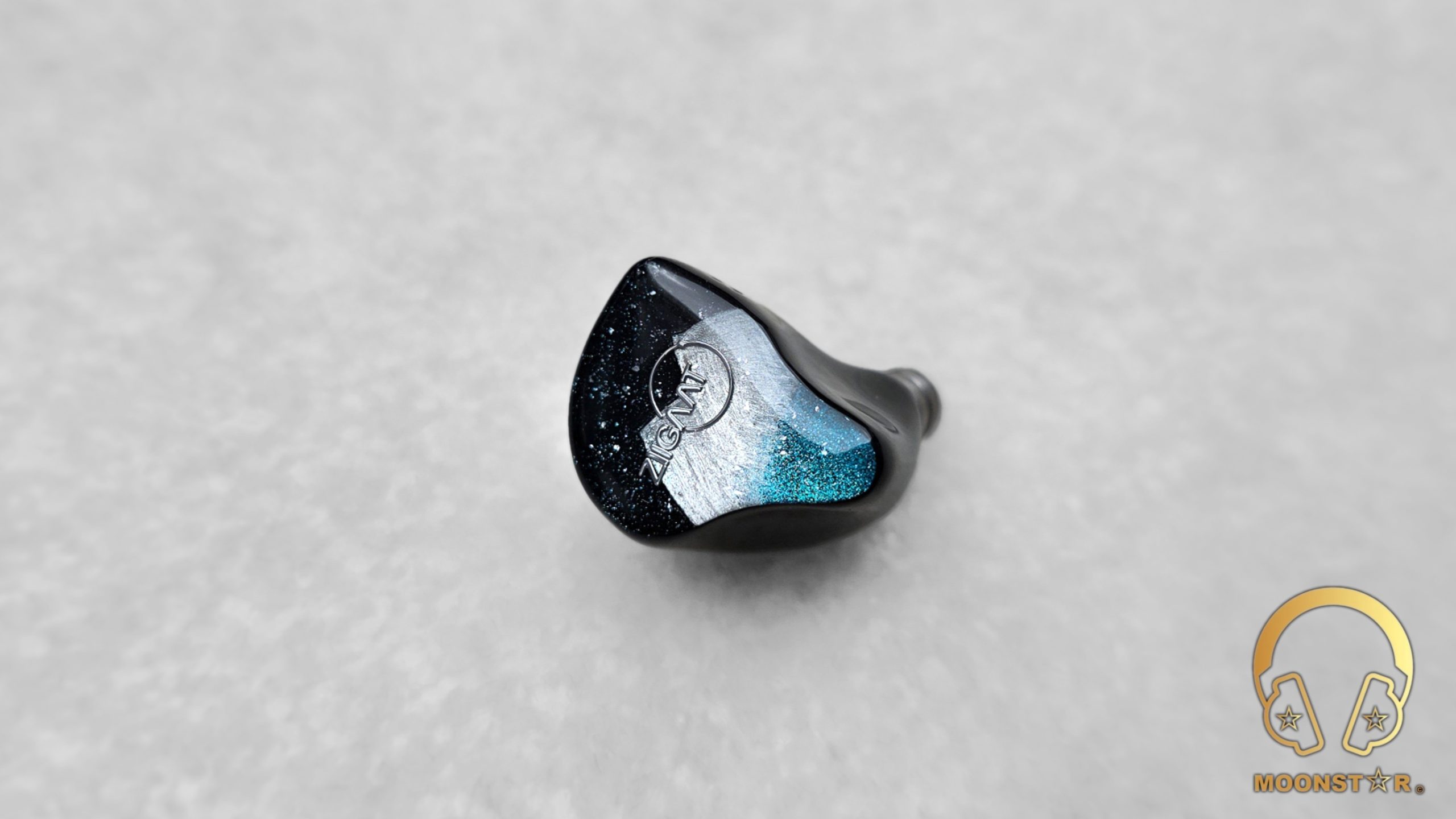
Comparisons:
ZiiGaat Horizon vs. BQEYZ Winter II:
When analyzing the low-frequency performance, the ZiiGaat Horizon presents a clean, fast sound characterized by controlled depth and a natural texture. My listening reveals a balanced low end that prioritizes speed and intricate detail, successfully ensuring that the bass integrates smoothly and cohesively without ever overwhelming the upper frequencies. The BQEYZ Winter II, leveraging its unique bone conduction and dynamic driver configuration, generates a distinctively deeper, more visceral bass. This is marked by enhanced sub-bass rumble and a palpable physical impact that is felt as much as it is heard. I find the Winter II offers a fuller, more authoritative low-end presence that clearly excels in electronic and genuinely bass-heavy genres. While the Winter II’s low end is undeniably powerful and immediately immersive, giving it an undeniable edge in sheer slam and quantity, the Horizon maintains its appeal with a refined, articulate sound that many discerning listeners, myself included, will appreciate for its superior precision and neutrality. If a richer, more intensely impactful bass is a primary requirement, the Winter II is likely the superior choice, but the Horizon remains an excellent option for those seeking a highly well-rounded, reference-grade low-end experience across various musical styles.
In the midrange, the Horizon truly distinguishes itself by offering clear, spacious vocal presentations and transparent instrument separation. I find that female voices are rendered with a smooth, almost effortless expressiveness, while male voices carry natural depth and texture. Crucially, instruments maintain distinctly separated acoustic space even in the most complex tracks. The Winter II, in contrast, features a warmer, slightly more forward midrange tuning. This tuning results in a richer, though occasionally slightly recessed, vocal presentation when encountered in busy mixes. This presentation means that vocals and instruments can adopt a more colored, emotional tone, which may lead to a fractional loss of transparency in denser arrangements. The Horizon’s commitment to neutrality provides it with a clear advantage for vocal clarity and resolution, whereas the Winter II offers a cozier, more intimate and emotionally engaging sound. For listeners prioritizing a spacious, highly accurate vocal presence, I would recommend the Horizon, but if a warmer, more emotionally engaging midrange is preferred, the Winter II may prove more appealing.

Moving into the treble region, the Horizon expertly delivers crisp, extended highs that achieve an excellent balance between intricate detail and smoothness, along with a pleasant airiness. This tuning ensures comfortable listening, even throughout prolonged sessions. The Winter II counters this with a brighter, more energetic treble response, infusing tracks with a lively sparkle and enhanced micro-detail. I must caution that this emphasis on energy can sometimes result in the sound leaning towards sharpness or sibilance, depending on the specific recording or source pairing. The Horizon’s approach feels more polished and fatigue-free, consistently prioritizing extension and controlled composure, while the Winter II emphasizes excitement and brilliance, which may benefit from careful source or eartip matching to successfully tame potential peaks. If one prefers a highly polished, airy, and non-fatiguing treble, the Horizon is the better choice, but fans of a bolder, more immediately sparkling high end will likely favor the Winter II’s presentation.
Finally, in terms of soundstage and imaging, the Horizon successfully creates an open, holographic soundstage that genuinely immerses me in a spacious and cohesive soundscape. Its imaging is precise, effortlessly placing instruments with pinpoint accuracy for a vivid, three-dimensional experience. The Winter II, influenced by its bone conduction component, offers a stage that is perceived as wider but perhaps slightly more diffuse, enveloping the listener with an impressive sense of depth and height. However, I find its central imaging to be less surgically pinpoint than the Horizon’s focused placement. The Horizon’s focused placement excels when analyzing intricate, multi-layered tracks, but the Winter II’s expansive presentation captivates with a grander, more atmospheric sense of space, appealing strongly to those who value immersion over analytical precision.
ZiiGaat Horizon vs. ROSE Technics QT-X:
The ZiiGaat Horizon and ROSE Technics QT-X showcase distinctly different sonic philosophies, particularly evident in their low-end presentations. The Horizon provides a bass that is clean and highly precise, imbued with controlled texture and a natural decay that achieves a balanced and detailed low end, successfully integrating smoothly into the overall sound without overwhelming other frequencies. In sharp contrast, the QT-X, with its hybrid dynamic and Balanced Armature (BA) configuration, delivers a punchier, more overtly elevated bass. This is characterized by a notable boost in mid-bass warmth and a fuller, more energetic presence. While the QT-X’s low end offers a “fun” and immediately engaging quality, slightly surpassing the Horizon in both quantity and warmth, the Horizon maintains its appeal with a sound that is both refined and articulate, strongly favoring accuracy and tonal truth. Ultimately, the QT-X clearly caters to listeners desiring a livelier and more bass-forward experience, yet the Horizon remains a strong contender for a neutral, reference-oriented, and technically precise low-end foundation.
Shifting my focus to the midrange, the Horizon shines with a clear, balanced vocal delivery and outstanding instrument separation. I find that female voices are rendered with smooth expressiveness, and male voices gain natural depth, all while instruments remain distinctly separated even in intricate mixes. The QT-X, on the other hand, presents a warmer, slightly forward midrange. This tuning results in a richer, but occasionally congested, vocal presentation. Here, vocals and instruments adopt a more colored tonal quality, gaining physical body but, in my assessment, losing some transparency in busier tracks. The Horizon’s dedication to neutrality gives it a definite edge for vocal clarity and micro-resolution, whereas the QT-X offers a more overtly musical, less analytical sound. If an accurate, spacious, and highly articulate vocal presence is what is sought, the Horizon will most likely appeal, but those preferring a warmer, more intimate, and richly colored midrange may find the QT-X more to their liking.
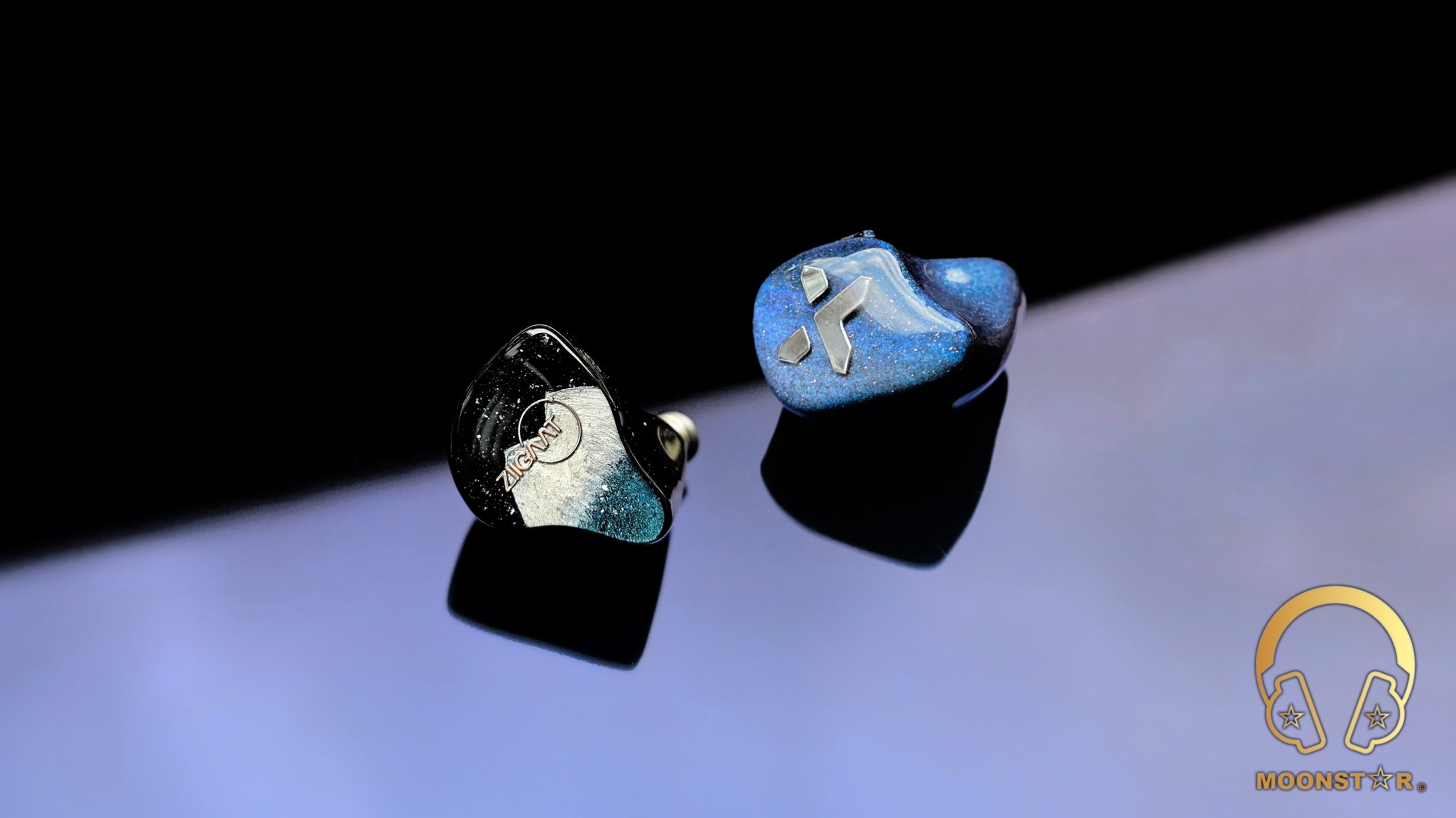
The Horizon delivers crisp, refined highs that expertly balance detail with extension and air, successfully ensuring a comfortable and fatigue-free listening experience, even during long sessions. The QT-X, however, counters with a brighter, more aggressive treble. This imbues tracks with a sharp sparkle and a forward burst of energy. I find this approach can sometimes verge on harshness or stridency with certain recordings or less forgiving sources. The Horizon’s treble approach feels inherently smoother and more controlled, prioritizing fatigue-free extension, while the QT-X emphasizes excitement and outright brilliance, which may certainly benefit from careful accessory choices like eartip rolling or source matching to achieve optimal balance. For a polished, airy, and consistently refined treble, the Horizon is the clear ideal, but fans of a bold, highly energetic, and sparkling high end will likely prefer the more immediate intensity of the QT-X.
Finally, considering soundstage and imaging, the Horizon crafts an open, holographic soundstage that genuinely immerses listeners in a spacious, cohesive soundscape. Its precise imaging effortlessly places instruments for a vivid, distinctly layered experience. Moving to the QT-X, its tuning results in a narrower, more intimate stage, intentionally enveloping the listener with focus and density, though I find its overall imaging feels just a slight step less expansive and surgically defined than the Horizon’s. The Horizon’s wider placement and precision excel in complex, multi-layered tracks that demand separation, but the QT-X’s concentrated presentation captivates with a more direct, “in-your-head” intimacy, appealing to those who favor immediate engagement over broad spatial precision.
Conclusion:
The ZiiGaat Horizon successfully secures a distinct position in the IEM market through its finely tuned neutral sound signature, expertly blending technical precision with natural musicality. The five-driver tribrid configuration delivers a cohesive performance across the spectrum: controlled bass, spacious mids, and smooth, extended treble. This focus on accuracy and detail makes it a compelling choice for both audiophiles and professionals engaged in genres like jazz, classical, and progressive rock. I find this balanced approach ensures the sound remains engaging yet fatigue-free during long sessions.
Beyond the audio quality, the Horizon emphasizes user experience and comfort. The shells are crafted from lightweight, medical-grade resin and feature unique, hand-poured faceplates, pairing striking aesthetics with excellent ergonomics and robust noise isolation. The included accessories further enhance its versatility, most notably the modular cable with both 3.5mm and 4.4mm terminations, which allows for effortless pairing with diverse audio sources. The inclusion of various ear tips and a semi-hard case elevates the overall practicality. Priced at $329 USD, the Horizon provides a high-level, detailed, and polished listening experience. For those who prioritize tonal balance, clarity, and adaptability, I believe the ZiiGaat Horizon is an inspired and highly recommendable choice in this price bracket.

Pros & Cons:
- + Neutral sound with controlled bass
- + Spacious midrange with great sense of clarity and resolution
- + Extended treble
- + Good level imaging for precise instrument placement
- + Lightweight and ergonomic resin shells
- + Beautiful looking hand-poured faceplates with artistic design
- + Modular 3.5mm/4.4mm cable
- – Bass, while fast and clean with great separation, may lack quantity for bass enthusiasts
- – Same accessories and packaging like previous ZiiGaat IEM’s
Thank you for the Read!


